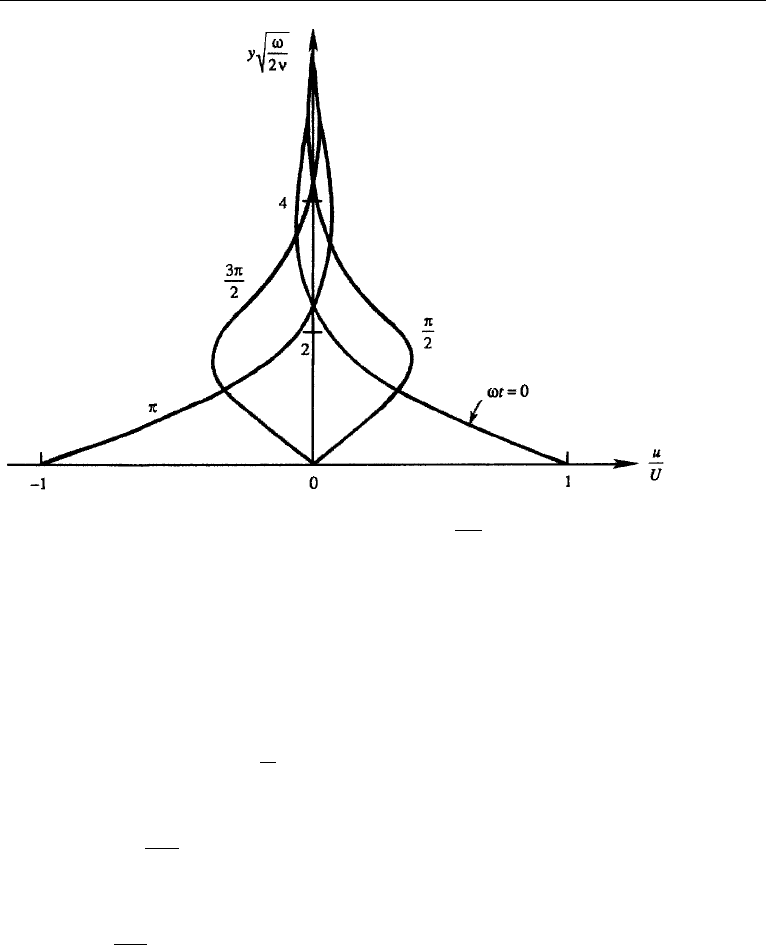Cohen I.M., Kundu P.K. Fluid Mechanics
Подождите немного. Документ загружается.


312 Laminar Flow
An Alternative Method of Deducing the Form of η
Instead of arriving at the form of η from dimensional considerations, it could be
derived by a different method as illustrated in the following. Denoting the thickness
of the flow by δ(t), we assume similarity solutions in the form
u
U
= F(η),
η =
y
δ(t)
.
(9.33)
Then equation (9.17) becomes
UF
∂η
∂t
= νU
∂
2
F
∂y
2
. (9.34)
The derivatives in equation (9.34) are computed from equation (9.33):
∂η
∂t
=−
y
δ
2
dδ
dt
=−
η
δ
dδ
dt
,
∂η
∂y
=
1
δ
,
∂F
∂y
= F
∂η
∂y
=
F
δ
,
∂
2
F
∂y
2
=
1
δ
∂F
∂y
=
F
δ
2
.
Substitution into equation (9.34) and cancellation of factors give
−
δ
ν
dδ
dt
ηF
= F
.
Since the right-hand side can only be an explicit function of η, the coefficient in
parentheses on the left-hand side must be independent of t. This requires
δ
ν
dδ
dt
= const. = 2, for example.
Integration gives δ
2
= 4νt, so that the flow thickness is δ = 2
√
νt. Equation (9.33)
then gives η = y/(2
√
νt), which agrees with our previous finding.
Method of Laplace Transform
Finally, we shall illustrate the method of Laplace transform for solving the prob-
lem. Let ˆu(y, s) be the Laplace transform of u(y, t). Taking the transform of equa-
tion (9.17), we obtain
s ˆu = ν
d
2
ˆu
dy
2
, (9.35)

8. Diffusion of a Vortex Sheet 313
where the initial condition (9.18) of zero velocity has been used. The transform of
the boundary conditions (9.19) and (9.20) are
ˆu(0,s) =
U
s
, (9.36)
ˆu(∞,s)= 0. (9.37)
Equation (9.35) has the general solution
ˆu = Ae
y
√
s/ν
+ Be
−y
√
s/ν
,
where the constants A(s) and B(s) are to be determined from the boundary conditions.
The condition (9.37) requires that A = 0, while equation (9.36) requires that B =
U/s. We then have
ˆu =
U
s
e
−y
√
s/ν
.
The inverse transform of the preceding equation can be found in any mathematical
handbook and is given by equation (9.31).
We have discussed this problem in detail because it illustrates the basic diffusive
nature of viscous flows and also the mathematical techniques involved in finding
similarity solutions. Several other problems of this kind are discussed in the following
sections, but the discussions shall be somewhat more brief.
8. Diffusion of a Vortex Sheet
Consider the case in which the initial velocity field is in the form of a vortex sheet
with u = U for y>0 and u =−U for y<0. We want to investigate how the vortex
sheet decays by viscous diffusion. The governing equation is
∂u
∂t
= ν
∂
2
u
∂y
2
,
subject to
u(y, 0) = U sgn(y),
u(∞,t) = U,
u(−∞,t) =−U,
where sgn(y) is the “sign function,” defined as 1 for positive y and −1 for negative
y. As in the previous section, the parameter U can be eliminated from the governing
set by regarding u/U as the dependent variable. Then u/U must be a function of
(y,t,ν), and a dimensional analysis reveals that there must exist a similarity solution
in the form

314 Laminar Flow
u
U
= F(η),
η =
y
2
√
νt
.
The detailed arguments for the existence of a solution in this form are given
in the preceding section. Substitution of the similarity form into the governing set
transforms it into the ordinary differential equation
F
=−2ηF
,
F(+∞) = 1,
F(−∞) =−1,
whose solution is
F(η) = erf(η).
The velocity distribution is therefore
u = U erf
y
2
√
νt
. (9.38)
A plot of the velocity distribution is shown in Figure 9.11. If we define the width of
the transition layer as the distance between the points where u =±0.95U , then the
Figure 9.11 Viscous decay of a vortex sheet. The right panel shows the nondimensional solution and the
left panel indicates the vorticity distribution at two times.

9. Decay of a Line Vortex 315
corresponding value of η is ± 1.38 and consequently the width of the transition layer
is 5.52
√
νt.
It is clear that the flow is essentially identical to that due to the impulsive start
of a flat plate discussed in the preceding section. In fact, each half of Figure 9.11
is identical to Figure 9.10 (within an additive constant of ±1). In both problems
the initial delta-function-like vorticity is diffused away. In the present problem the
magnitude of vorticity at any time is
ω =
∂u
∂y
=
U
√
πνt
e
−y
2
/4νt
. (9.39)
This is a Gaussian distribution, whose width increases with time as
√
t, while the
maximum value decreases as 1/
√
t. The total amount of vorticity is
∞
−∞
ωdy = 2
√
νt
∞
−∞
ωdη =
2U
√
π
∞
−∞
e
−η
2
dη = 2U,
which is independent of time, and equals the y-integral of the initial (delta-function-
like) vorticity.
9. Decay of a Line Vortex
In Section 6 it was shown that when a solid cylinder of radius R is rotated at angu-
lar speed in a viscous fluid, the resulting motion is irrotational with a velocity
distribution u
θ
= R
2
/r. The velocity distribution can be written as
u
θ
=
2πr
,
where = 2πR
2
is the circulation along any path surrounding the cylinder. Sup-
pose the radius of the cylinder goes to zero while its angular velocity correspondingly
increases in such a way that the product = 2πR
2
is unchanged. In the limit we
obtain a line vortex of circulation , which has an infinite velocity discontinuity at
the origin.
Now suppose that the limiting (infinitely thin and fast) cylinder suddenly stops
rotating at t = 0, thereby reducing the velocity at the origin to zero impulsively. Then
the fluid would gradually slow down from the initial distribution because of viscous
diffusion from the region near the origin. The flow can therefore be regarded as that of
the viscous decay of a line vortex, for which all the vorticity is initially concentrated
at the origin. The problem is the circular analog of the decay of a plane vortex sheet
discussed in the preceding section.
Employing cylindrical coordinates, the governing equation is
∂u
θ
∂t
= ν
∂
∂r
1
r
∂
∂r
(ru
θ
)
, (9.40)

316 Laminar Flow
subject to
u
θ
(r, 0) = /2πr, (9.41)
u
θ
(0,t) = 0, (9.42)
u
θ
(r →∞,t) = /2πr. (9.43)
We expect similarity solutions here because there are no natural scales for r and t
introduced from the boundary conditions. Conditions (9.41) and (9.43) show that the
dependence of the solution on the parameter /2πr can be eliminated by defining a
nondimensional velocity
u
≡
u
θ
/2πr
, (9.44)
which must have a dependence of the form
u
= f(r,t,ν).
As the left-hand side of the preceding equation is nondimensional, the right-hand side
must be a nondimensional function of r, t , and ν. A dimensional analysis quickly
shows that the only nondimensional group formed from these is r/
√
νt. Therefore,
the problem must have a similarity solution of the form
u
= F(η),
η =
r
2
4νt
.
(9.45)
(Note that we could have defined η = r/2
√
νt as in the previous problems, but the
algebra is slightly simpler if we define it as in equation (9.45).) Substitution of the
similarity solution (9.45) into the governing set (9.40)–(9.43) gives
F
+ F
= 0,
subject to
F(∞) = 1,
F(0) = 0.
The solution is
F = 1 − e
−η
.
The dimensional velocity distribution is therefore
u
θ
=
2πr
[1 − e
−r
2
/4νt
]. (9.46)
A sketch of the velocity distribution for various values of t is given in Figure 9.12.
Near the center (r 2
√
νt) the flow has the form of a rigid-body rotation, while in
the outer region (r 2
√
νt) the motion has the form of an irrotational vortex.

10. Flow Due to an Oscillating Plate 317
Figure 9.12 Viscous decay of a line vortex showing the tangential velocity at different times.
The foregoing discussion applies to the decay of a line vortex. Consider now
the case where a line vortex is suddenly introduced into a fluid at rest. This can be
visualized as the impulsive start of an infinitely thin and fast cylinder. It is easy to
show that the velocity distribution is (Exercise 5)
u
θ
=
2πr
e
−r
2
/4νt
, (9.47)
which should be compared to equation (9.46). The analogous problem in heat con-
duction is the sudden introduction of an infinitely thin and hot cylinder (containing a
finite amount of heat) into a liquid having a different temperature.
10. Flow Due to an Oscillating Plate
The unsteady parallel flows discussed in the three preceding sections had similarity
solutions, because there were no natural scales in space and time. We now discuss
an unsteady parallel flow that does not have a similarity solution because of the
existence of a natural time scale. Consider an infinite flat plate that executes sinusoidal
oscillations parallel to itself. (This is sometimes called Stokes’ second problem.) Only
the steady periodic solution after the starting transients have died will be considered;
thus there are no initial conditions to satisfy. The governing equation is
∂u
∂t
= ν
∂
2
u
∂y
2
, (9.48)

318 Laminar Flow
subject to
u(0,t) = U cos ωt, (9.49)
u(∞,t) = bounded . (9.50)
In the steady state, the flow variables must have a periodicity equal to the periodicity
of the boundary motion. Consequently, we use a separable solution of the form
u = e
iωt
f(y), (9.51)
where what is meant is the real part of the right-hand side. (Such a complex form
of representation is discussed in Chapter 7, Section 15.) Here, f(y) is complex,
thus u(y, t) is allowed to have a phase difference with the wall velocity U cos ωt.
Substitution of equation (9.51) into the governing equation (9.48) gives
iωf = ν
d
2
f
dy
2
. (9.52)
This is an equation with constant coefficients and must have exponential solu-
tions. Substitution of a solution of the form f = exp(ky) gives k =
√
iω/ν =
±(i + 1)
√
ω/2ν, where the two square roots of i have been used. Consequently,
the solution of equation (9.52) is
f(y) = Ae
−(1+i)y
√
ω/2ν
+ Be
(1+i)y
√
ω/2ν
. (9.53)
The condition (9.50), which requires that the solution must remain bounded at y =∞,
needs B = 0. The solution (9.51) then becomes
u = Ae
iωt
e
−(1+i)y
√
ω/2ν
. (9.54)
The surface boundary condition (9.49) now gives A = U . Taking the real part of
equation (9.54), we finally obtain the velocity distribution for the problem:
u = Ue
−y
√
ω/2ν
cos
ωt − y
ω
2ν
. (9.55)
The cosine term in equation (9.55) represents a signal propagating in the direction
of y, while the exponential term represents a decay in y. The flow therefore resem-
bles a damped wave (Figure 9.13). However, this is a diffusion problem and not a
wave-propagation problem because there are no restoring forces involved here. The
apparent propagation is merely a result of the oscillating boundary condition. For
y = 4
√
ν/ω, the amplitude of u is U exp(−4/
√
2) = 0.06U, which means that the
influence of the wall is confined within a distance of order
δ ∼ 4
ν/ω, (9.56)
which decreases with frequency.

10. Flow Due to an Oscillating Plate 319
Figure 9.13 Velocity distribution in laminar flow near an oscillating plate. The distributions at ωt = 0,
π/2, π, and 3π/2 are shown. The diffusive distance is of order δ = 4
√
ν/ω.
Note that the solution (9.55) cannot be represented by a single curve in terms of
the nondimensional variables. This is expected because the frequency of the bound-
ary motion introduces a natural time scale 1/ω into the problem, thereby violating
the requirements of self-similarity. There are two parameters in the governing set
(9.48)–(9.50), namely, U and ω. The parameter U can be eliminated by regarding
u/U as the dependent variable. Thus the solution must have a form
u
U
= f (y, t, ω,ν). (9.57)
As there are five variables and two dimensions involved, it follows that there must
be three dimensionless variables. A dimensional analysis of equation (9.57) gives
u/U , ωt, and y
√
ω/ν as the three nondimensional variables as in equation (9.55).
Self-similar solutions exist only when there is an absence of such naturally occurring
scales requiring a reduction in the dimensionality of the space.
An interesting point is that the oscillating plate has a constant diffusion dis-
tance δ = 4
√
ν/ω that is in contrast to the case of the impulsively started plate
in which the diffusion distance increases with time. This can be understood from
the governing equation (9.48). In the problem of sudden acceleration of a plate,
∂
2
u/∂y
2
is positive for all y (see Figure 9.10), which results in a positive ∂u/∂t
everywhere. The monotonic acceleration signifies that momentum is constantly
diffused outward, which results in an ever-increasing width of flow. In contrast,
in the case of an oscillating plate, ∂
2
u/∂y
2
(and therefore ∂u/∂t) constantly

320 Laminar Flow
changes sign in y and t. Therefore, momentum cannot diffuse outward monotonically,
which results in a constant width of flow.
The analogous problem in heat conduction is that of a semi-infinite solid, the
surface of which is subjected to a periodic fluctuation of temperature. The resulting
solution, analogous to equation (9.55), has been used to estimate the effective “eddy”
diffusivity in the upper layer of the ocean from measurements of the phase difference
(that is, the time lag between maxima) between the temperature fluctuations at two
depths, generated by the diurnal cycle of solar heating.
11. High and Low Reynolds Number Flows
Many physical problems can be described by the behavior of a system when a certain
parameter is either very small or very large. Consider the problem of steady flow
around an object described by
ρu
•
∇u =−∇p + µ∇
2
u. (9.58)
First, assume that the viscosity is small. Then the dominant balance in the flow is
between the pressure and inertia forces, showing that pressure changes are of order
ρU
2
. Consequently, we nondimensionalize the governing equation (9.58) by scaling
u by the free-stream velocity U , pressure by ρU
2
, and distance by a representative
length L of the body. Substituting the nondimensional variables (denoted by primes)
x
=
x
L
u
=
u
U
p
=
p − p
∞
ρU
2
, (9.59)
the equation of motion (9.58) becomes
u
•
∇u
=−∇p
+
1
Re
∇
2
u
, (9.60)
where Re = Ul/ν is the Reynolds number. For high Reynolds number flows, equa-
tion (9.60) is solved by treating 1/Re as a small parameter. As a first approximation,
we may set 1/Re to zero everywhere in the flow, thus reducing equation (9.60) to
the inviscid Euler equation. However, this omission of viscous terms cannot be valid
near the body because the inviscid flow cannot satisfy the no-slip condition at the
body surface. Viscous forces do become important near the body because of the high
shear in a layer near the body surface. The scaling (9.59), which assumes that veloc-
ity gradients are proportional to U/L, is invalid in the boundary layer near the solid
surface. We say that there is a region of nonuniformity near the body at which point
a perturbation expansion in terms of the small parameter 1/Re becomes singular.
The proper scaling in the boundary layer and the procedure of solving high Reynolds
number flows will be discussed in Chapter 10.
Now consider flows in the opposite limit of very low Reynolds numbers, that is,
→0. It is clear that low Reynolds number flows will have negligible inertia forces
and therefore the viscous and pressure forces should be in approximate balance.

11. High and Low Reynolds Number Flows 321
For the governing equations to display this fact, we should have a small parameter
multiplying the inertia forces in this case. This can be accomplished if the variables are
nondimensionalized properly to take into account the low Reynolds number nature of
the flow. Obviously, the scaling (9.59), which leads to equation (9.60), is inappropriate
in this case. For if equation (9.60) were multiplied by Re, then the small parameter
Re would appear in front of not only the inertia force term but also the pressure force
term, and the governing equation would reduce to 0 = µ∇
2
u as Re → 0, which is
not the balance for low Reynolds number flows. The source of the inadequacy of the
nondimensionalization (9.59) for low Reynolds number flows is that the pressure is
not of order ρU
2
in this case. As we noted in Chapter 8, for these external flows,
pressure is a passive variable and it must be normalized by the dominant effect(s),
which here are viscous forces. The purpose of scaling is to obtain nondimensional
variables that are of order one, so that pressure should be scaled by ρU
2
only in high
Reynolds number flows in which the pressure forces are of the order of the inertia
forces. In contrast, in a low Reynolds number flow the pressure forces are of the
order of the viscous forces. For ∇p to balance µ∇
2
u in equation (9.58), the pressure
changes must have a magnitude of the order
p ∼ Lµ∇
2
u ∼ µU/L.
Thus the proper nondimensionalization for low Reynolds number flows is
x
=
x
L
u
=
u
U
p
=
p − p
∞
µU/L
. (9.61)
The variations of the nondimensional variables u
and p
in the flow field are now
of order one. The pressure scaling also shows that p is proportional to µ inalow
Reynolds number flow. A highly viscous oil is used in the bearing of a rotating shaft
because the high pressure developed in the oil film of the bearing “lifts” the shaft and
prevents metal-to-metal contact.
Substitution of equation (9.61) into (9.58) gives the nondimensional equation
Re u
•
∇u
=−∇p
+∇
2
u
. (9.62)
In the limit Re → 0, equation (9.62) becomes the linear equation
∇p = µ∇
2
u, (9.63)
where the variables have been converted back to their dimensional form.
Flows at Re 1 are called creeping motions. They can be due to small velocity,
large viscosity, or (most commonly) the small size of the body. Examples of such
flows are the motion of a thin film of oil in the bearing of a shaft, settling of sediment
particles near the ocean bottom, and the fall of moisture drops in the atmosphere. In
the next section, we shall examine the creeping flow around a sphere.
Summary: The purpose of scaling is to generate nondimensional variables that
are of order one in the flow field (except in singular regions or boundary layers).
